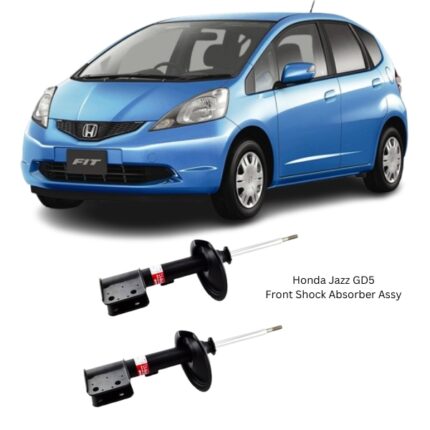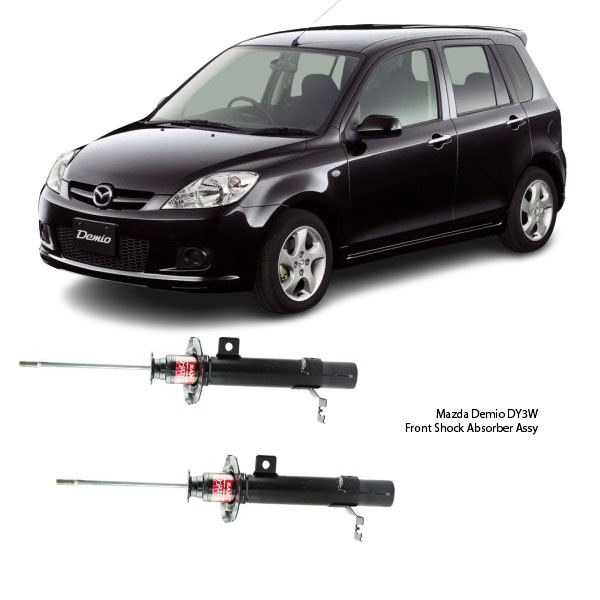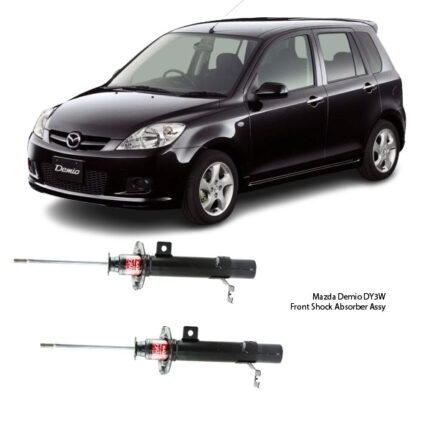Get Mazda Demio DY3W Front Shock Absorber Assy 333414 in Kenya
The Front Shock Absorber Assembly is a key component in a vehicle’s suspension system, designed to manage the motion of the front wheels and maintain contact between the tires and the road. As the first point of interaction between road irregularities and the vehicle, the front shock absorber is instrumental in providing ride comfort, control, and safety. It absorbs the energy from bumps, potholes, and uneven terrain, preventing it from being transferred to the vehicle’s body or cabin.
Let’s break down everything you need to know about this critical part, including how it works, why it matters, and when to replace it.
What is a Front Shock Absorber Assembly?
The front shock absorber assembly is a hydraulic or gas-filled component mounted between the vehicle’s chassis and its front suspension system. It’s responsible for damping the oscillations created by the springs and controlling the up-and-down motion of the front wheels.
In modern vehicles, especially those with MacPherson strut suspensions, the shock absorber often integrates with a coil spring and is referred to as a strut assembly. In other setups, the shock absorber and coil spring are separate. Regardless of the configuration, their purpose remains the same—dampening the impact and movement to ensure a stable and smooth ride.
How It Works
When a car drives over a bump or dips into a pothole, the front coil springs compress and decompress to absorb the shock. Without dampening, the vehicle would bounce uncontrollably. This is where the shock absorber comes in. It slows down and controls this motion by converting kinetic energy into heat energy through hydraulic fluid resistance.
Inside the shock, a piston moves within a cylinder filled with fluid or gas. As the suspension compresses or rebounds, the fluid is forced through tiny valves, creating resistance that absorbs energy and smooths out the ride.
Main Components of a Front Shock Absorber Assembly
A complete front shock absorber assembly includes the following:
-
Shock Absorber (Damper) – The core part that provides resistance to motion.
-
Piston and Cylinder – The moving part inside the tube that forces fluid through valves.
-
Coil Spring – In strut-type assemblies, this surrounds the shock and supports vehicle weight.
-
Top Mount (Strut Mount) – Connects the assembly to the vehicle body and often includes a bearing.
-
Dust Boot and Bump Stop – Protects internal components from debris and prevents bottoming out.
-
Mounting Hardware – Bushings, bolts, and washers used for secure installation.
Purpose and Importance
The front shock absorber’s purpose is to:
-
Control Suspension Movement: Reduces bouncing after a bump or pothole.
-
Maintain Tire Contact: Keeps the front wheels in constant contact with the road for optimal steering and braking.
-
Enhance Stability and Handling: Improves vehicle control during acceleration, braking, and cornering.
-
Reduce Body Roll and Nose Dive: Minimizes excessive leaning during turns and forward dip during braking.
-
Protect Other Components: Absorbs impact forces, preserving the integrity of tires, suspension arms, and steering components.
Benefits of a Quality Front Shock Absorber Assembly
-
Improved Ride Comfort: Reduces jarring and vibrations transferred to the cabin.
-
Better Steering Response: Keeps the front end planted for more precise handling.
-
Enhanced Safety: Shorter braking distances and better road traction during emergencies.
-
Extended Tire Life: Prevents uneven tire wear by minimizing irregular motion.
-
Lower Maintenance Costs: Reduces stress on suspension and steering parts.
Types of Front Shock Absorbers
There are several types of front shocks used in vehicles:
-
Twin-Tube Shocks: Consist of an inner and outer cylinder. Common and affordable.
-
Mono-Tube Shocks: Single-tube design offering improved cooling and performance.
-
Gas-Charged Shocks: Use pressurized nitrogen gas to reduce foaming and improve responsiveness.
-
Coilover Assemblies: Combine shock and spring in one unit, offering compact design and adjustability.
-
Electronic Adjustable Shocks: Found in high-end vehicles, these adjust damping force in real-time.
Signs of a Worn Front Shock Absorber Assembly
-
Excessive Bouncing: Vehicle nose dips when braking or bounces after a bump.
-
Poor Steering Response: Loose or imprecise steering feel.
-
Nose Dive: Front end dips excessively under braking.
-
Uneven Tire Wear: Especially on the inner or outer edges of the front tires.
-
Fluid Leaks: Oil seeping from the shock absorber body.
-
Clunking or Knocking Noises: Especially when going over speed bumps or rough roads.
-
Vehicle Pulling: Tendency to drift left or right due to uneven damping.
Risks of Driving with Faulty Front Shocks
Operating a vehicle with bad front shock absorbers can lead to:
-
Reduced Braking Efficiency: Longer stopping distances.
-
Loss of Control: Especially in wet conditions or during emergency maneuvers.
-
Premature Tire and Suspension Wear: Increases cost of repairs over time.
-
Increased Driver Fatigue: Due to constant corrections and vibrations.
-
Higher Risk of Bottoming Out: When the front end hits the bump stops or frame.
When to Replace Front Shock Absorbers
Most shocks are designed to last between 80,000 to 100,000 kilometers, though this can vary based on driving habits, load, and road quality. If any of the warning signs appear, or during major suspension overhauls, it’s best to inspect and replace as necessary.
Pro Tip: Always replace both front shock absorbers at the same time to ensure even performance.
How to Replace a Front Shock Absorber Assembly
-
Lift the Vehicle – Securely jack up the front and remove the wheels.
-
Remove Old Assembly – Unbolt the top mount and bottom bolts from the control arm or knuckle.
-
Inspect Surrounding Components – Check the condition of control arms, ball joints, and bushings.
-
Install the New Assembly – Mount securely, aligning it properly to avoid misalignment.
-
Torque Bolts to Specification – Use a torque wrench for proper fit.
-
Reinstall Wheels and Lower Vehicle – Follow up with a wheel alignment to prevent uneven tire wear.
Safety Note: Spring compression can be dangerous—use proper tools or consult a mechanic.
Follow us on Facebook for more parts.




